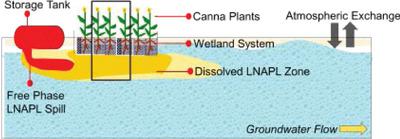当前位置:
X-MOL 学术
›
Clean - Soil Air Water
›
论文详情
Our official English website, www.x-mol.net, welcomes your
feedback! (Note: you will need to create a separate account there.)
In Situ Bioremediation of Toluene‐Polluted Vadose Zone: Integrated Column and Wetland Study
Clean - Soil Air Water ( IF 1.5 ) Pub Date : 2020-05-18 , DOI: 10.1002/clen.202000118 Shreejita Basu 1, 2 , Brijesh Kumar Yadav 3 , Shashi Mathur 2 , Pankaj Kumar Gupta 4
Clean - Soil Air Water ( IF 1.5 ) Pub Date : 2020-05-18 , DOI: 10.1002/clen.202000118 Shreejita Basu 1, 2 , Brijesh Kumar Yadav 3 , Shashi Mathur 2 , Pankaj Kumar Gupta 4
Affiliation

|
A vertical soil column setup integrated with wetlands is developed to study the biodegradation and transport of toluene, a light non‐aqueous phase liquid (LNAPL), in the subsurface environment. LNAPL‐contaminated water is applied to infiltrate from the top of the soil column. The observed and simulated breakthrough curves show high equilibrium concentration at top ports rather than at lower ports, indicating effective toluene biodegradation with soil depth. The observed equilibrium concentration of toluene is higher in the case of unplanted wetland, asserting an accelerated biodegradation rate in the planted case. A difference in the relative concentration of toluene between input and output fluxes at 100 h is found as 13.34% and 30.86% for planted and unplanted wetland setups, respectively. Estimated biodegradation rates show that toluene degradation is 2.5 times faster in the planted wetland setup. In addition, the difference in the observed bacterial count and dissolved oxygen prove that toluene degraded aerobically at a faster rate in the planted setup. Simulations show that as time reached 80–100 h, there is no significant change in concentration profile, thereby confirming the equilibrium condition. The results of this study will be useful to frame plant‐assisted bioremediation techniques for LNAPL‐contaminated soil–water resources in the field.
中文翻译:

甲苯污染的渗流带的原位生物修复:色谱柱和湿地研究
开发了与湿地结合的垂直土壤柱装置,以研究地下环境中甲苯(一种轻质非水相液体(LNAPL))的生物降解和运输。用LNAPL污染的水从土壤柱的顶部渗透。观察到的和模拟的穿透曲线显示出顶部端口而不是下部端口的平衡浓度高,表明甲苯有效降解随土壤深度的变化。在未种植的湿地中观察到的甲苯平衡浓度较高,这表明在种植的情况下生物降解速率加快。对于种植和未种植的湿地设施,在100 h输入和输出通量之间的甲苯相对浓度差异分别为13.34%和30.86%。估计的生物降解速度表明,在人工湿地中甲苯降解速度快2.5倍。另外,观察到的细菌数量和溶解氧的差异证明,在种植环境中甲苯以更快的速度需氧降解。模拟表明,当时间达到80–100 h时,浓度曲线没有明显变化,从而确定了平衡条件。这项研究的结果将有助于构建田间LNAPL污染的土壤水资源的植物辅助生物修复技术。浓度曲线没有明显变化,从而确认了平衡条件。这项研究的结果将有助于构建田间LNAPL污染的土壤水资源的植物辅助生物修复技术。浓度曲线没有明显变化,从而确认了平衡条件。这项研究的结果将有助于构建田间LNAPL污染的土壤水资源的植物辅助生物修复技术。
更新日期:2020-05-18
中文翻译:

甲苯污染的渗流带的原位生物修复:色谱柱和湿地研究
开发了与湿地结合的垂直土壤柱装置,以研究地下环境中甲苯(一种轻质非水相液体(LNAPL))的生物降解和运输。用LNAPL污染的水从土壤柱的顶部渗透。观察到的和模拟的穿透曲线显示出顶部端口而不是下部端口的平衡浓度高,表明甲苯有效降解随土壤深度的变化。在未种植的湿地中观察到的甲苯平衡浓度较高,这表明在种植的情况下生物降解速率加快。对于种植和未种植的湿地设施,在100 h输入和输出通量之间的甲苯相对浓度差异分别为13.34%和30.86%。估计的生物降解速度表明,在人工湿地中甲苯降解速度快2.5倍。另外,观察到的细菌数量和溶解氧的差异证明,在种植环境中甲苯以更快的速度需氧降解。模拟表明,当时间达到80–100 h时,浓度曲线没有明显变化,从而确定了平衡条件。这项研究的结果将有助于构建田间LNAPL污染的土壤水资源的植物辅助生物修复技术。浓度曲线没有明显变化,从而确认了平衡条件。这项研究的结果将有助于构建田间LNAPL污染的土壤水资源的植物辅助生物修复技术。浓度曲线没有明显变化,从而确认了平衡条件。这项研究的结果将有助于构建田间LNAPL污染的土壤水资源的植物辅助生物修复技术。











































 京公网安备 11010802027423号
京公网安备 11010802027423号